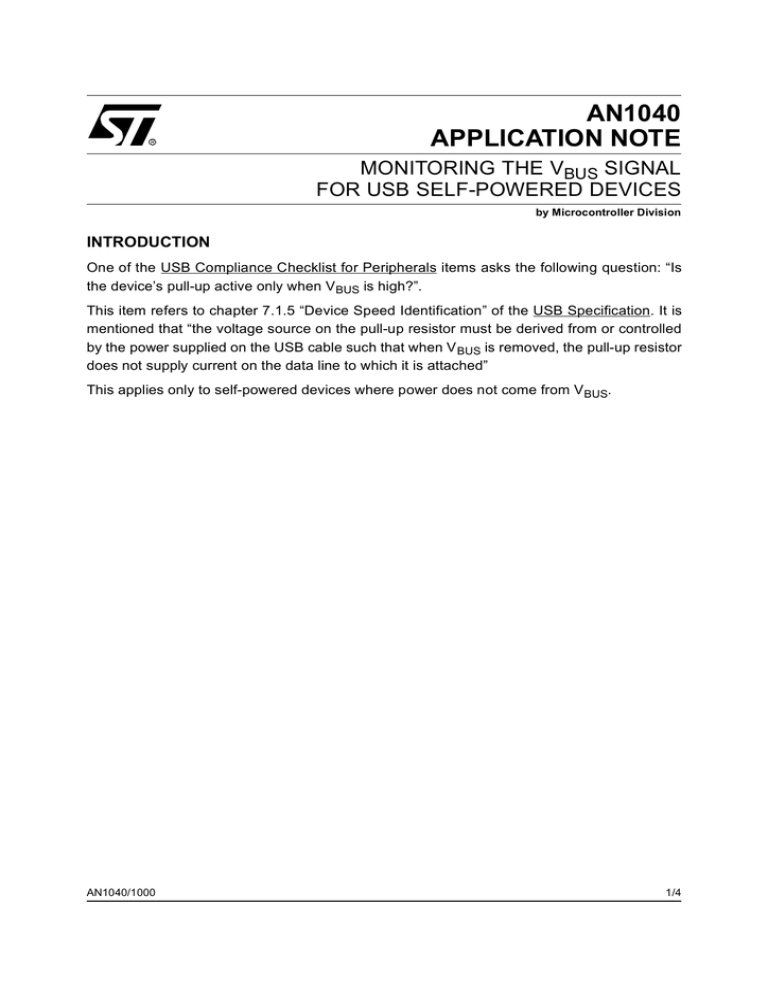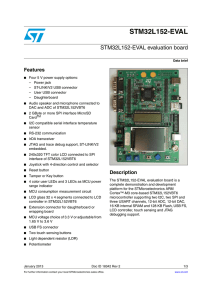
AN1040
APPLICATION NOTE
MONITORING THE VBUS SIGNAL
FOR USB SELF-POWERED DEVICES
by Microcontroller Division
INTRODUCTION
One of the USB Compliance Checklist for Peripherals items asks the following question: “Is
the device’s pull-up active only when V BUS is high?”.
This item refers to chapter 7.1.5 “Device Speed Identification” of the USB Specification. It is
mentioned that “the voltage source on the pull-up resistor must be derived from or controlled
by the power supplied on the USB cable such that when V BUS is removed, the pull-up resistor
does not supply current on the data line to which it is attached”
This applies only to self-powered devices where power does not come from V BUS.
AN1040/1000
1/4
1
1 VBUS MONITORING
ST7 and ST9 microcontrollers with an embedded USB interface are equipped with an on-chip
3.3V voltage regulator that pulls up the appropriate data line with a 1.5 kΩ ±5% resistor.
This regulator can be switched on or off by software via the PDWN (Power Down) bit.
When the USB microcontroller is used in a self-powered application, it has to monitor the V BUS
signal to power off the 3.3 V voltage regulator if the USB cable is removed or if the V BUS is
switched off.
This can be implemented using an I/O pin configured as input CMOS.
Two monitoring schemes are possible:
1. Monitoring by polling the I/O pin in the main loop of the microcontroller program.
2. Monitoring by interrupt if the I/O pin connected to the VBUS signal has interrupt capability. If
VBUS is removed, an interrupt will be generated on the falling edge.
Figure 1. VBUS Configuration
5V
Main Loop
USB
Microcontroller
USB connector B
Vbus
1.5KOhm
I/Opin
I/O Pin High
NO
USBVCC
D+
USBDP
D-
USBDM
GND
USBGND
YES
Set PDWN bit of
USBCTLR register
to power off 3.3V
voltage regulator
Main loop process
When the VBUS signal is removed, the program must set the PDWN bit. This will power off the
3.3V on-chip voltage regulator that supplies the external pull-up resistor and the transceiver
and as a result, current will not be supplied on the data line attached to the VBUS signal.
2/4
2
2 REFERENCE DOCUMENTS
1. Universal Serial Bus Specification, Compaq Intel Microsoft NEC, Revision 1.1, September
23, 1998
2. USB Compliance Checklist, “Peripherals (excluding Hubs) for the Universal Serial Bus
Specification (version 1.1)”, USB Implementors Forum, Version 1.06, August 16, 1999
3/4
"THE PRESENT NOTE WHICH IS FOR GUIDANCE ONLY AIMS AT PROVIDING CUSTOMERS WITH INFORMATION
REGARDING THEIR PRODUCTS IN ORDER FOR THEM TO SAVE TIME. AS A RESULT, STMICROELECTRONICS
SHALL NOT BE HELD LIABLE FOR ANY DIRECT, INDIRECT OR CONSEQUENTIAL DAMAGES WITH RESPECT TO
ANY CLAIMS ARISING FROM THE CONTENT OF SUCH A NOTE AND/OR THE USE MADE BY CUSTOMERS OF
THE INFORMATION CONTAINED HEREIN IN CONNEXION WITH THEIR PRODUCTS."
Information furnished is believed to be accurate and reliable. However, STMicroelectronics assumes no responsibility for the consequences
of use of such information nor for any infringement of patents or other rights of third parties which may result from its use. No license is granted
by implication or otherwise under any patent or patent rights of STMicroelectronics. Specifications mentioned in this publication are subject
to change without notice. This publication supersedes and replaces all information previously supplied. STMicroelectronics products are not
authorized for use as critical components in life support devices or systems without the express written approval of STMicroelectronics.
The ST logo is a registered trademark of STMicroelectronics
2000 STMicroelectronics - All Rights Reserved.
Purchase of I2C Components by STMicroelectronics conveys a license under the Philips I2C Patent. Rights to use these components in an
I2C system is granted provided that the system conforms to the I2C Standard Specification as defined by Philips.
STMicroelectronics Group of Companies
Australia - Brazil - China - Finland - France - Germany - Hong Kong - India - Italy - Japan - Malaysia - Malta - Morocco - Singapore - Spain
Sweden - Switzerland - United Kingdom - U.S.A.
http://www.st.com
4/4





